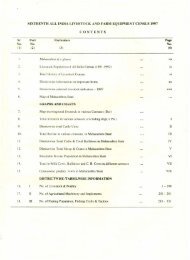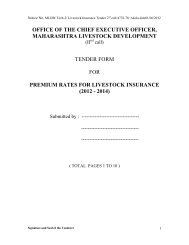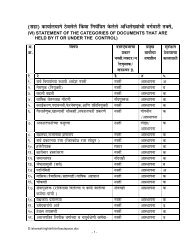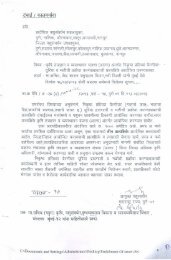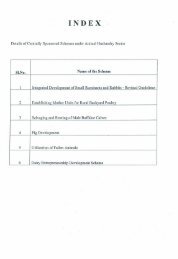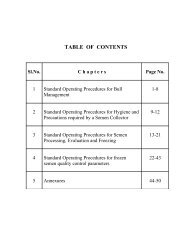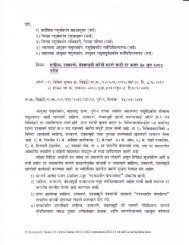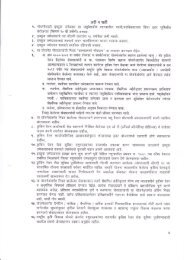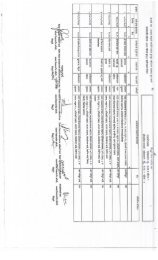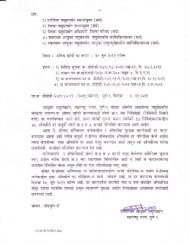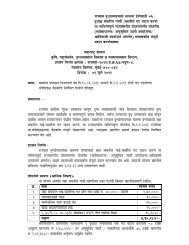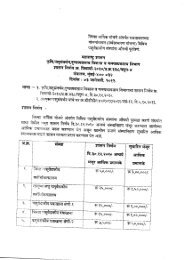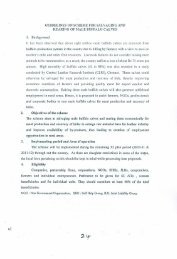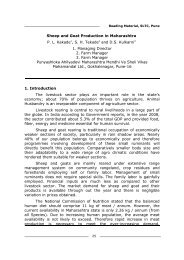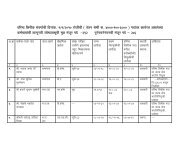Trypanosomiasis - Animal Husbandry Department
Trypanosomiasis - Animal Husbandry Department
Trypanosomiasis - Animal Husbandry Department
You also want an ePaper? Increase the reach of your titles
YUMPU automatically turns print PDFs into web optimized ePapers that Google loves.
Introduction:<br />
TRYPANOSOMIASIS<br />
<strong>Trypanosomiasis</strong> in animals is a disease complex caused by<br />
several species of protozoan parasites of the genus<br />
Trypanosoma. <strong>Trypanosomiasis</strong> caused by Trypanosoma<br />
evansi is the most widely distributed pathogenic,<br />
mechanically transmitted vector borne haemoprotozoan<br />
disease of domestic livestock and wild animals in India. In<br />
tropical countries like India the disease is also called as<br />
Surra and is transmitted through a non cyclical method by<br />
biting flies such as a Tabanidae. The disease is transmitted<br />
cyclically by different species of Tsetse fly ( Glosina sp. )<br />
mainly in Africa. The geographical area affected by<br />
trypanosomiasis caused by T. evansi is greater than area<br />
affected by tsetse borne trypanosomiasis in Africa. The<br />
disease can affect almost all species of mammals but from<br />
economic and zoonotic point of view, trypanosomiasis is an<br />
important disease of cattle, buffaloes, sheep, goats, horses<br />
and camels. It is a potential killer of livestock and causes<br />
economic losses to the farmers in terms of morbidity,<br />
mortality, abortion, infertility, reduced milk yield, The<br />
Office International Epizooties (OIE) mentions the disease<br />
under list B diseases of significance in horses. The disease is<br />
also reported in rodents caused by T. Lewisi.<br />
Synonyms: Surra caused by T. evansi., Tribersa in camels,<br />
Dourine in Horses caused by T. equipardum.<br />
Zoonotic aspect:<br />
<strong>Trypanosomiasis</strong> in humans is a disease prevalent in Africa<br />
and Central and South America. Trypanosoma brucei causes<br />
sleeping sickness in Africa and T. Crusie causes Chagas<br />
disease in central and south America. There are very few<br />
reports ( one or two ) of accidental transmission of animal<br />
trypanosomiasis to human beings in Asia.<br />
Since 2004 three cases of human trypanosomiasis have been<br />
reported from three different geographical locations in<br />
Maharashtra. The first case was reported in October 2004<br />
and was of a 45 year old male, a cattle breeder by profession<br />
from village Shivni, Tal Sindewahi, Dist. Chandrapur and<br />
was infected by T. Evansi. The second case was a three<br />
month old child from Mumbai, infected with T. Lewisi in<br />
September 2006 and a third case was of a 55 year old male<br />
from village Paud, Tal. Mulshi, Dist. Pune, also infected<br />
with T. Lewisi. The first two cases recovered after<br />
administration of Suramin and other supportive therapy,<br />
however the third case succumbed to the infection.<br />
Morphology :<br />
T. evansi is a member of subgenus Trypanozoon and is<br />
described as monomorphic but may be pleomorphic in some<br />
strains with length of 15 to 34 μm. Leaf-like slender forms<br />
are characterized by a long free flagellum with narrow and<br />
drawn out posterior end.<br />
Epidemiology:<br />
The monsoon and post monsoon seasons are most conducive<br />
for propagation of the disease due to the preponderance of<br />
tabanid flies. However, cases of surra are encountered<br />
throughout the year. Surra has also been detected in animals<br />
of arid and semi-arid regions of our state with warm and<br />
temperate climate.<br />
Clinical Signs and postmortem findings :<br />
Clinical signs are not pathognomic and hence clinical<br />
examination is of little help in pinpointing the diagnosis. T.<br />
evansi infected animals show progressive loss of appetite,<br />
body weight, oedema of lower parts of body, intermittent<br />
fever, bilateral enlargement of prescapular lymph nodes,<br />
corneal opacity, salivation, lacrimation and abortion. There<br />
is fever, which is intermittent and animals loose condition.<br />
They are anemic and there is a severe drop in milk<br />
production. Some animals may have improper gait, show<br />
circling movements and shaking of head.<br />
Like clinical signs postmortem findings are also not<br />
definitive. The carcass is marked by anaemia, emaciation,<br />
anasarca, enlargement of lymphnodes, liver and spleen.<br />
There may be corneal opacity and testicular degeneration.<br />
Diagnosis :<br />
Confirmative diagnosis of trypanosomiasis must rely on<br />
parasitological techniques, that confirm the presence of the<br />
parasite either by microscopic examination of blood or by<br />
using sophisticated techniques like ELISA and PCR. Though<br />
several diagnostic techniques exist for diagnosis of surra.,<br />
only few tests have been critically evaluated and<br />
standardized. Conventional parasitological techniques (CPT)<br />
followed include examination of wet blood film and stained<br />
thin and thick blood smears. Blood smears should be made<br />
from capillary blood collected from peripheral<br />
circulation i.e. ( ear tip ). They should be stained with<br />
Leishmans or Giemsa stain. Parasites can also be found in<br />
other body fluids and tissues.<br />
Mouse inoculation (MI) test is generally regarded and<br />
accepted as the most sensitive method to detect the animal<br />
trypanosomiasis. If buffy coat is used for inoculating the<br />
mice, the sensitivity is further increased.<br />
Serological detection of anti trypanosomal antibodies in<br />
serum also helps in diagnosis. <strong>Trypanosomiasis</strong> is<br />
characterized by fluctuating parasitaemia with periods of<br />
paroxysms and intermission.<br />
Trpanosomes in blood smear :<br />
Treatment and Control :<br />
The present strategy for treatment and control depends<br />
mainly on chemotherapy and chemoprophylaxis but has<br />
certain limitations. The major problems are availability of<br />
few drugs, development of drug resistance, high price of<br />
drugs and toxicity to the drugs ( narrow therapeutic index<br />
and hence administration of correct dosage is essential).<br />
Currently available drugs include diminazene aceturate
(berenil), quinapyramine sulphate (Antricyde sulphate) and<br />
Antricyde prosalt ( quinapyramine sulphate + quinapyramine<br />
chloride ) for treatment and prophylactic use against<br />
trypanosomiasis in domestic animals. The dose of<br />
quinapyramine sulphate (Antricyde sulphate) is 3 – 5 mg. /<br />
Kg. body wt.and is given s/c. It is safe and efficient for<br />
treating surra and is active against suramin resisitant strains.<br />
The dose of Antricyde prosalt ( quinapyramine sulphate ( 1.5<br />
parts) + quinapyramine chloride ( 1 part ) w/w ) is 7.4 mg. /<br />
Kg. body wt. s/c. The mixture has the same activity as that<br />
of quinapyramine sulphate but chloride compound results in<br />
formation of subcutaneous depot from which it is released<br />
slowly, resulting in prophylactic effect for about three<br />
months. The dose of diminazene aceturate (berenil) is 3.5<br />
mg. / Kg. body wt. I/M. Besides trypanosomiasis it is<br />
effective against babesiosis. It is easily excreted, therefore<br />
resistance against it is comparatively less. A severe side<br />
effect develops in higher doses. In camel and dog it should<br />
be used with precaution only under the supervision of<br />
veterinarian and along with supportive therapy. There are<br />
variable reports on the therapeutic efficacy of diminazene<br />
aceturate in buffaloes, but in general, diminazene is<br />
considered as sanative drug and found to be very effective in<br />
treatment of trypanosomiasis in buffaloes. Quinappyramine<br />
sulphate and diminazene remains the mainstay for the<br />
treatment because of non-availability of suramin and less<br />
activity<br />
of samorin.<br />
These available drugs should be used judiciously and in<br />
correct doses only after confirmatory diagnosis to avoid<br />
drug resistance and toxicity. Resistance develops more<br />
quickly to prophylactic drugs as compared to curative drugs,<br />
because curative drugs are eliminated rapidly from the body.<br />
Among curative drugs, resistance develops only after<br />
repeated use in endemic areas. Suboptimal doses of drugs<br />
are also responsible for development of resistance.Since<br />
trypanosomiasis is an disease transmitted by arthropod<br />
vector viz. the tabanus flies, mass campaign for eradication<br />
of Tabanus can be tried, but it has limited value under field<br />
conditions as elimination or reduction of flies from the<br />
environment<br />
is difficult.<br />
Immuno prophylaxis is not possible because of non<br />
availability of effective vaccine against trypanosomiasis.<br />
For further details contact :<br />
JOINT COMMISSIONER OF ANIMAL HUSBANDRY<br />
WESTERN REGIONAL DISEASE DIAGNOSTIC<br />
LABORATORY<br />
DISEASE INVESTIGATION SECTION<br />
AUNDH, PUNE-411 007. M.S. INDIA.<br />
PH. 020-25692135, FAX. 020-25691474<br />
E-mail : jcahdis@hotmail.com<br />
Compiled by<br />
Dr. V.V.Limaye.,<br />
Assistant Commisioner<br />
of A.H.<br />
Parasitology<br />
Dr. P.T.Ganvir,<br />
Joint Commissioner of A.H.<br />
TRYPANOSOMIASIS ( SURRA )<br />
Regional Disease Diagnostic Laboratory<br />
(Western zone)<br />
Disease Investigation Section,<br />
Aundh, Pune – 411007



